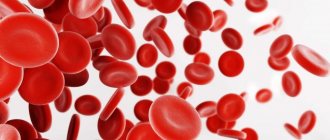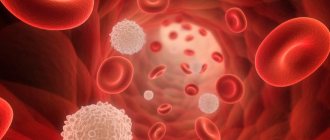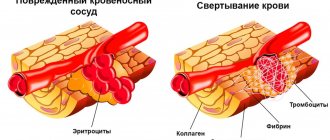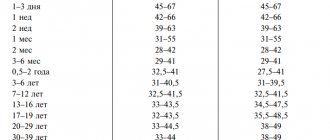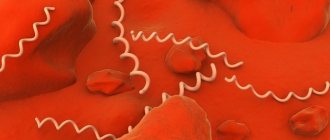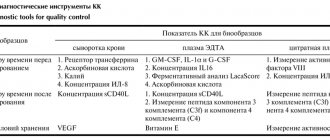Biochemical blood test for a child
- a highly informative method of laboratory diagnostics, which allows you to diagnose (study) many diseases, pathologies, inflammatory processes and assess the functioning of the internal organs and systems of the child’s body.
A blood test for biochemistry (research, interpretation) helps the pediatrician establish or confirm a diagnosis, prescribe and adjust treatment, and determine at what stage the child’s disease is.
Indications for biochemical blood tests
The study is carried out at the first stage of diagnosing any somatic diseases of any profile. It is mandatory to refer a patient for blood biochemistry in case of the following complaints and symptoms:
- Regular disruptions in digestion (nausea, vomiting, heaviness in the abdomen, bloating, flatulence, diarrhea or constipation, heartburn, discomfort in the hypochondrium);
- Sustained pain of any localization (headache, muscle, joint, in the area of internal organs);
- Respiratory disorders (persistent cough, shortness of breath, spasms);
- Signals from the nervous system (tremor of the limbs, chronic fatigue, insomnia, dizziness and fainting);
- Malfunctions of the genitourinary system (changes in the smell and color of urine, changes in the frequency of urination, discomfort during the process);
- Signals from the cardiovascular system (rapid or rare heartbeat, high or low blood pressure);
- Weakness of the immune system, which is expressed in frequent and long-lasting respiratory diseases;
- Pathological changes in the skin and the presence of visible tumors on the body;
- Signs of endocrine disorders (persistent thirst or hunger, sudden changes in weight, constant feeling of heat or cold).
Boys and girls
Due to physiological characteristics, collecting urine from boys is much easier. You can “catch” the stream of urine with a container or lower your penis into the container and wait. It is very convenient to use a urinal, which is made specifically for boys. Both the penis and testicles are placed in such a urinal.
In little girls, collecting urine is much more difficult. If there is a urinal, then you need to attach it in a circle, capturing only the labia majora. If there is no urine bag, then you will have to use a wide, but not very deep plate. Pre-wash it and pour boiling water over it. Hold the girl over (or next to) a plate and wait for her to pee.
How to prepare for donating blood for “biochemistry”?
In order for the results to be as accurate as possible, you must follow the rules for preparing for a blood test for a biochemical study:
- Within two days, switch to a gentle diet - eliminate fatty, sweet, spicy, salty, smoked foods, and also give up alcohol, coffee and strong tea;
- The day before, refrain from any stressful procedures and activities for the body - baths and saunas, contrast showers, heavy physical activity;
- If you are taking medications, discuss with your doctor whether they will affect the test results;
- 6-12 hours before the BAC, you should not eat any food or smoke. You are only allowed to drink plain water.
Standard Analysis Indicators
What indicators relate to standard biochemical analysis?
Standard biochemical blood parameters include the following:
- Protein metabolism: (Albumin, Total protein, C-reactive protein, Glycated hemoglobin, Glycated hemoglobin, Transferrin, Ferritin, Serum iron binding capacity)
- Enzymes: (Alanine aminotransferase, Aspartate aminotransferase, Gamma-glutamyltransferase, Amylase, Lactate, Creatine kinase, Alkaline phosphatase)
- Lipids: (Total cholesterol, HDL cholesterol, Triglycerides)
- Carbohydrates: (Glucose, Fructosamine)
- Pigments: (total bilirubin, direct bilirubin)
- Low molecular weight nitrogenous substances: (Creatinine, Uric acid, Urea)
- Inorganic substances and vitamins: (Iron, Potassium, Calcium, Sodium, Chlorine, Magnesium, Phosphorus, B Vitamins)
As you can see, there are quite a lot of main indicators of a biochemical blood test; only a specialist can choose the right one, and even more so, interpret the results of the analysis in the relationship of individual indicators.
Biochemical blood test indicators have their own norm. The normal value of the indicators largely depends on the age and gender of the patient.
| General blood analysis |
| Blood test biochemistry |
Decoding and data of normal indicators
The result of the analysis is a conclusion, which is usually a table about the content of chemicals and biological agents in the blood. The first column indicates the indicator, the second - the identified value, and the third - the normal range. Only a specialist, assessing the indicators, can determine the presence of disturbances in water-salt metabolism, identify inflammatory processes and infections, and also assess the performance status of all the patient’s organs.
As for normal indicators, the data for adults looks like this:
| Analysis | Men | Women |
| Total protein | 64-84 g/l. | 64-84 g/l. |
| Hemoglobin | 130-160 g/l | 120-150 g/l. |
| Haptoglobin | 150-2000 mg/l | 150-2000 mg/l |
| Glucose | 3.30-5.50 mmol/l. | 3.30-5.50 mmol/l. |
| Urea | 2.5-8.3 mmol/l. | 2.5-8.3 mmol/l. |
| Creatinine | 62-115 µmol/l | 53-97 µmol/l. |
| Cholesterol | 3.5-6.5 mmol/l. | 3.5-6.5 mmol/l. |
| Bilirubin | 5-20 µmol/l. | 5-20 µmol/l. |
| AlAT (ALT) | up to 45 units/l. | up to 31 units/l. |
| ASAT (AST) | up to 45 units/l. | up to 31 units/l. |
| Lipase | 0-190 units/l. | 0-190 units/l. |
| Alpha amylase | 28-100 units/l. | 28-100 units/l. |
| Pancreatic amylase | 0-50 units/l. | 0-50 units/l. |
Decoding the main indicators of the LHC
Total protein.
A biochemical blood test determines the total concentration of various proteins, which consist of amino acids. Protein takes an active part in the processes of coagulation, processing and transport of nutrients to organs and tissues.
Hemoglobin.
This specific protein from the red blood cell system is responsible for transporting oxygen in the body
Haptoglobin.
A blood plasma protein that binds hemoglobin and is responsible for preserving iron in the body. Also involved in the control of local inflammatory processes.
Glucose.
An important component responsible for carbohydrate metabolism. Its content in arterial blood is higher than in venous blood.
Urea.
This is the main product of protein breakdown, in which nitrogen unnecessary by the body is removed in the urine.
Creatinine.
This, like urea, is the end product of protein metabolism. The content of creatinine in the blood depends on gender, age, and muscle mass.
Cholesterol
. A component of fat metabolism, which is also involved in the construction of cell membranes and the synthesis of vitamin D and sex hormones. Another name is cholesterol. There are: total cholesterol, low-density lipoprotein (LDL) and high-density lipoprotein (HDL) cholesterol.
Bilirubin
. The breakdown product of hemoglobin, a toxic substance of two types: direct and indirect. They form a “general” one and the norm when deciphering a biochemical blood test is indicated specifically for it.
AlAT (ALT).
Alanine aminotransferase is an enzyme contained in the cells of the liver, kidneys and heart, so its presence in the blood indicates the destruction of the cells of these organs.
AST (AST).
Aspartate aminotransferase is a cellular enzyme that is involved in the metabolism of amino acids and is found in the liver cells of the heart and kidneys.
Lipase.
An enzyme that promotes the breakdown of fats.
Amylase.
It breaks down carbohydrates from food and ensures their digestion. There are alpha-amylase (diastase) and pancreatic amylase.
It is important to remember that only a specialist can evaluate the results of a blood test, decipher a biochemical analysis, make a diagnosis and prescribe treatment!
Taking blood from children
Taking blood from children
The younger the child, the more difficult it is for him to describe his sensations and localize the pain. Parents often show concern only if the child’s activity decreases, loss of appetite, or rise in body temperature. On the other hand, most childhood diseases are reflected in changes in blood counts, which, together with an examination and assessment of the child’s condition, will allow the doctor to make the correct diagnosis.
However, taking blood from children for testing is quite difficult, both technically and psychologically. Difficulties are associated both with compliance with the requirements for preparing for research and with the procedure itself.
The main difficulties are associated with obtaining a sufficient volume of blood, especially in children in the first three years of life. Their capillary network is poorly developed, the vessels and their lumen are small, and the blood has increased viscosity, because contains a high concentration of cells. The maximum volumes of blood that can be taken from a child at one time mainly depend not on age, but on his weight (Table 1). Unreasonably frequent and extensive studies lead to changes in blood parameters (decrease in hemoglobin, hematocrit, red blood cells, etc.) without a pathological reason.
The disadvantages of capillary blood sampling are associated with a greater likelihood of distorted results or the need for repeated sampling. This is due to:
- destruction of blood cells during collection,
- formation of microclots in the sample,
- the presence of intercellular fluid in the sample,
- contamination of the sample with skin microflora,
- short sample shelf life.
It is important to understand that taking blood from a vein is less painful than taking blood from a finger and is free of the negative effects described above. To facilitate the collection of venous blood, the child should be kept warm; parents rhythmically squeeze and unclench the child's wrist to facilitate blood flow. The child must get used to the room and calm down. It is advisable to give him 50-100 ml of clean water without gas half an hour before taking blood. Try to draw blood in the first half of the day, 4-6 hours after a light morning breakfast.
WHO does not recommend more than two attempts to collect venous blood from children and newborns. If for some reason it was not possible to draw blood, depending on the criticality of obtaining test results, you should postpone it until the next day.
To collect blood from a vein in children, the same tubes are used as in adults. The volume of each tube is 4-5 ml. In departments of newborns and young children, special pediatric tubes are used with the same fillers as regular tubes, but with a volume of 1-2 ml.
| Patient weight, kg | Maximum rate of blood collection at one time, ml | Maximum rate of blood collection for the entire period of hospitalization, ml |
| 2,7–3,6 | 2,5 | 23 |
| 3,6–4,5 | 3,5 | 30 |
| 4,5–6,8 | 5 | 40 |
| 7,3–9,1 | 10 | 60 |
| 9,5–11,4 | 10 | 70 |
| 11,8–13,6 | 10 | 80 |
| 14,1–15,9 | 10 | 100 |
| 16,4–18,2 | 10 | 130 |
| 18,6–20,5 | 20 | 140 |
| 20,9–22,7 | 20 | 160 |
| 23,2–25,0 | 20 | 180 |
| 25,5–27,3 | 20 | 200 |
| 27,7–29,5 | 25 | 220 |
| 30,0–31,8 | 30 | 240 |
| 32,3–34,1 | 30 | 250 |
| 34,5–36,4 | 30 | 270 |
| 36,8–38,6 | 30 | 290 |
| 39,1–40,9 | 30 | 310 |
| 41,4–43,2 | 30 | 330 |
| 43,6–45,5 | 30 | 350 |
Table 1. Maximum norms for blood collection at one time and for the entire duration of hospitalization in children under 14 years of age
Organization of the preanalytical stage during centralization of laboratory research. The recommendations were developed by a team of authors: Doctor of Medical Sciences A.A. Kishkun, Doctor of Medical Sciences, Professor A.Zh. Gilmanov, Doctor of Medical Sciences, Professor T.I. Dolgikh, D.A. Grishchenko, T.G Skorokhodova
Taking blood for laboratory tests in pediatric practice. Laboratory diagnostics - 2013, No. 3. — pp. 40-43
What not to do
- There is no need to squeeze the described diaper into a container and submit such an analysis to the laboratory: the results will be unreliable, because various microorganisms and tissue fibers will get from the diaper into the contents of the container.
- There is no need to use homemade urine bags. For example, making them from a plastic bag is both inconvenient and unhygienic.
- You cannot freeze the container with the analysis (any kind). The material collected the day before is unsuitable for research.
- Enemas and laxative suppositories should not be used to stimulate bowel movements, otherwise the laboratory material will contain foreign impurities and the study will be unreliable.
When the baby grows up, the procedure for collecting tests will become much simpler. Both urine and feces can be collected from the potty. The main thing is that before collecting samples, the pot must be washed clean, but without using cleaning products. Just wash it with baby soap or baking soda and rinse thoroughly with water.
Coprogram
You will need a clean container to collect this test. You can buy it at the pharmacy, it is almost no different from a container for collecting urine, the only thing is that it has a small spoon attached to its lid. It is not necessary to wash the child immediately before collecting this analysis.
The easiest way to collect feces is from a diaper - you need to take the contents from the surface. The volume of collected material should be approximately 5–10 g (1–2 teaspoons). If the baby's stool is liquid and analysis is necessary, you will have to place the child on medical oilcloth and then carefully pour the contents into a container.
For dysbacteriosis, feces cannot be collected from a diaper.
Enterobiasis: Collection of biomaterial is carried out only in the morning, before 10.00 am. Do not wash your child either the evening before or in the morning.
Prepare a glass slide by wiping it dry. Place the child on the side, bend the legs at the knees and bring them to the stomach, spread the buttocks and collect scrapings from the perianal folds around the anus using the “print” method in several places with adhesive transparent tape (adhesive tape) 4-5 cm long. Carefully stick the adhesive tape on a glass slide sticky side down. Bring it to the laboratory in this form. The slide can be obtained from the treatment room.
Antibody test
Antibodies to coronavirus detected in the body show its reaction to the pathogen. If it produces specific immunoglobulins, this may mean that:
- the person has had COVID-19 (including asymptomatic);
- antibodies are able to fight the virus if it re-enters the blood;
- a person can be a donor and save other infected people who suffer more severely from the disease.
If testing shows that antibodies to coronavirus are present, this does not mean that their carrier will never get sick again.
Although the statistics are small, virologists have concluded that a positive antibody test may briefly equate to vaccination. However, this is true for six months after the infection is detected. After this period, risks reappear, and the patient is recommended to be vaccinated.
Little tricks
There are some tricks that help you collect urine quickly and without difficulty:
- if a child sleeps in a diaper at night, then in the morning you just need to unfasten the diaper, the baby will become cool and he will pee;
- turn on the water - the murmur of water will speed up urination;
- press lightly with a warm hand on the lower abdomen, give a small massage;
- If the child already knows how to stand, then in the morning, in advance, turn on the warm water to heat the bottom of the bath. As soon as your baby wakes up, take him to the bathroom, put him in the bathtub and keep a container under him. The result will not take long to arrive.
Usually, the first morning urine is needed for research, but if a special analysis is required (according to Nechiporenko), then an average portion must be collected. But in a small child it is difficult to collect urine at all, and even more so the first urine in the morning. Therefore, just any morning urine sample is suitable for analysis.


